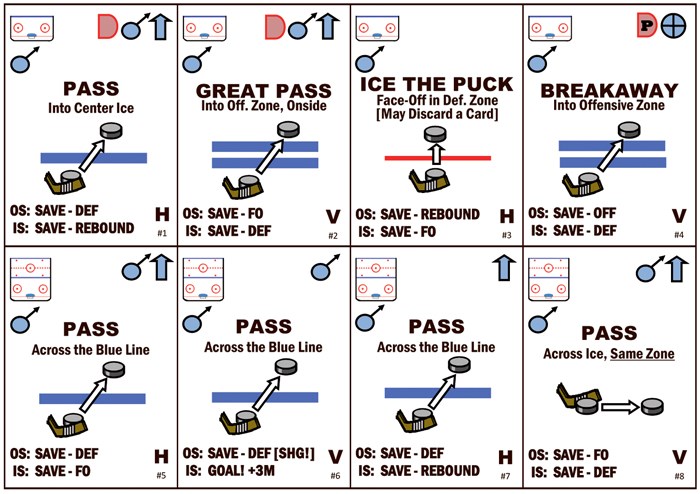There are games which are light fare, quick to learn, quick to play.
And there are games which opt for detail, the rulebooks growing thicker with each refinement.
Ice Cold Ice Hockey (ICIH), designed by Andrew S. Fisher in 2014, is certainly a game which falls into the realm of detailed games.
The game is basically a card game for two players which mimics a hockey game.
So in its simplest form a hockey game is about shooting and scoring.
There are however many details, from penalties and body checks, to offsides, icing and where to shoot on goal.
Fisher opted to include as much detail as he could, the result being a ruleset which printed in 17 8X11 pages. If that scares you, you are likely aware that with detail can come a crush of rules to learn.
Ice Cold is a game for those wanting to experience the finer points of hockey in a card game, and are willing to deal with the detailed rules required to make that happen.
As it notes on Boardgamegeek.com, “Ice Cold Ice Hockey is a thinking-man’s card game that has been designed to simulate all the excitement of professional ice hockey. An action deck of 64 cards, three rink-cards and comprehensive yet easy-to-understand rules comprise the complete game (although you’ll need to supply a few small tokens). The cards serve multiple purposes, including passing, skating, shooting, defense, shot-blocking and goaltending. Experienced players will be able to complete a game in about an hour.”
Note they put game play at an hour for experienced players. Expect much longer games with lots of referring to the rules as you work toward some level of experience in playing Ice Cold.
But the effort can be worth it if you are a huge hockey fan.
“In ICIH, you’ll experience all the excitement of professional ice hockey through a deck of 64 cards. You’ll be amazed how closely the experience will mirror an actual game. Sometimes you’ll effortlessly set up end-to-end plays and at other times you’ll be happy that you’re able to dump the puck out of your end. You’ll shoot from the point and, after some effort, from close-in. On defense, sometimes you’ll be able to challenge the puck-carrier and sometimes you won’t. Sometimes you’ll have to risk a penalty to stop an opponent’s scoring chance. Blocked shots, breakaways, fighting, frustration, momentum, super-saves – they’re all here in Ice Cold Ice Hockey,” explains the lead-in to the rules.
So by now you have the idea that Ice Cold requires some serious dedication. But how did the game come to be? Well Fisher has long liked hockey, and games.
“As a child growing up in northeast USA in the 1950’s, kids played in the snow during winter, but rainy weekends were problematic,” he said. “In those days, there wasn’t much to do in such weather, so we’d all meet at a friend’s house -- where our primary means of relieving boredom was board games.
“They seemed more intriguing to me than most of my friends, I suppose, and my interest has never really waned.”
The inspiration for Ice Cold was a growing American interest in the sport.
“In the mid-1970’s ice hockey took off in the USA. It was quite a different game back then-- a nice blend of speed, power and finesse, unlike today’s NHL (National Hockey League) games which seem like wrestling matches.” said Fisher. “I followed the NHL closely for about twenty years.
The process of creating a better game was not immediately easy.
“I made about six or seven attempts at an ice hockey game over the last 25-years,” said Fisher. “Ice Cold Ice hockey took three-to-four months to complete, maybe 200 hours or so.”
The challenge was finding balance within the game.
“Creating a fun, somewhat realistic game that made my play testers smile and that I’d like to play myself,” said Fisher. “I tried creating statistically-based games, move-pieces-around-a-rink games, card games-- you name it. These attempts all ended up in the trash can and nothing was satisfactory until I woke up in the middle of the night with the basic idea of ice cold ice hockey.”
So what is the innovative aspect Fisher thinks makes Ice Cold work well?
“Perhaps the icons that allows the most cards to be played only from certain zones of the rink,” he offered. “It creates choices for the player and hopefully adds a lot of ‘theme’ to the game.
“For example, I have a card in my hand that I can play if I have the puck at centre ice or in my offensive zone. I’m at centre ice and I can take an outside (routine) shot, pass or skate with this particular card.
“Unfortunately, the rest of my hand is composed of defensive cards.
“Time is running out in the period. Should I dump-and-chase or take the shot? Real hockey players make these decisions in split-seconds; of course, as a game player, you can think about it for a while.
“Hopefully, players will still get the real-life ‘feel’ of making such choices throughout the game.”
Players wanting to get a better feel for the game can find a link to a game-play video via the game’s listing on the aforementioned Boardgamegeek.
The rules and cards are available as print and play files on BGG. If you love hockey, and like detail in a game this is one to check out as it does offer lots of what happens on the ice in a deck of cards.




